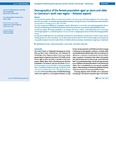Demographics of the female population aged 50 years and older in Germany’s north east region – Selected aspects
Nowossadeck, Enno
Prütz, Franziska
Thißen, Martin
Considerable demographic differences characterise the Berlin, Brandenburg and Mecklenburg-Western Pomerania region (the north east region), for example, regarding settlement patterns and age structures. These differences are also observed among women in the age group 50 years and older.The most conspicuous difference is population density. While Berlin is one of the most densely populated cities in Germany, Brandenburg and Mecklenburg-Western Pomerania are the two most sparsely populated federal states.In these two states, the female population is on average older than in Berlin, a fact particularly true of rural areas. Continuing migration is a contributing factor not only to a rise in average age but also to further decreasing population density.An essential consideration for rural area health care provision are the distances people need to travel to reach services. Having (access to) a car is a key factor. Yet, as older women are less likely than men of the same age to have (access to) a car, public transport and other modern forms of mobility (dial-a-bus services, shared taxis) are gaining in importance.
Dateien zu dieser Publikation

